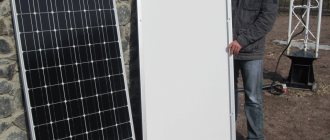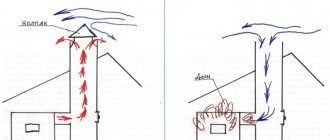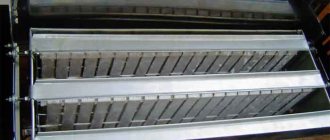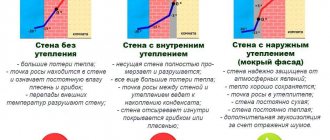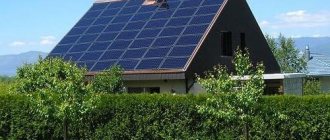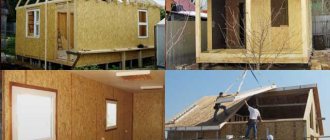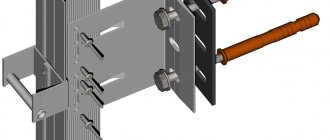How does a solar battery work?
All modern solar cells work thanks to the discovery made by physicist Alexandre Becquerel in 1839 of the very principle of operation of semiconductors.
We advise you to read the detailed article if a solar battery is something that is still unclear to you.
If you heat the silicon solar cells on the top wafer, the atoms of the silicon semiconductor are released. The atoms of the lower plate tend to capture them. In full accordance with the laws of physics, the electrons of the bottom plate must return to their original state. These electrons have one path open - through wires. The stored energy is transferred to the batteries and returned to the upper silicon wafer.
The most efficient solar panels: rating
The most efficient solar converters today are produced by Sharp. Three-layer, high-power, concentrating solar panels have an efficiency of 44.4%. Their cost is incredibly high, so they are used only in the aerospace industry.
The most affordable and effective are modern solar panels from the following companies:
- Panasonic Eco Solutions;
- First Solar;
- MiaSole;
- JinkoSolar;
- Trina Solar;
- Yingli Green;
- ReneSola;
- Canadian Solar.
Sun Power produces the most reliable solar inverters with an efficiency of 21.5%. The company's products are absolutely popular in commercial and industrial facilities, second only to devices from Q-Cells.
Where productivity is lost
The elements themselves contain very great possibilities. Theoretically, the efficiency of a solar panel can be 80–87%!
But from practice we know that their effectiveness is extremely low. The efficiency is actually in the range of 15–20%. This is precisely the portion of electricity that modern solar panels can generate from the entire solar flux falling on the receiving photocells.
- Imperfect production technology.
- Insufficiently pure components for manufacturing.
- Errors during assembly.
This is just a small part of the components of the reasons where energy efficiency goes.
It is also necessary to take into account weather conditions. No matter what modern solar panel is, it will not work effectively if the sun is covered by clouds or located above the horizon. This reason is difficult to regulate. This means the only remedy is to increase the efficiency of the panels themselves.
To these listed difficulties should be added the fact that the process of purification and obtaining crystals in itself is a rather expensive procedure. Without this necessary set of high-tech works, it is difficult to achieve the expected effect.
Of course, there are solar panels with high efficiency. But their final cost is so high that it is inaccessible to the mass buyer.
Impact on cell material performance
Depending on the semiconductor materials used in the design, the nominal efficiency of solar panels is:
- Amorphous silicon, A-Si.
For a long time, the conversion efficiency did not exceed 5-7%, but with the transition to thin-film technologies it rose to 14-16%. The efficiency is quite stable, since the “loose” shaped surface of the cells absorbs even weak or scattered light well. - Polycrystalline silicon, Poli-Si.
Nominal figures are in the range of 19-21%. The drop in performance under unfavorable light conditions is average, which is ensured by the multidirectional arrangement of the crystals of the absorbing layer. - Monocrystalline silicon, Mono-Si.
Provides the highest energy yield under ideal lighting conditions, up to 24%. When the position relative to the sun changes and high temperatures, the efficiency of such solar panels decreases significantly. - Cadmium telluride, Cd-Te.
This type of photovoltaic cell is rapidly gaining popularity due to its combination of high average efficiency and low price. More consistent performance than pure crystalline silicon modules is achieved by the ideal p/n junction band gap. The efficiency is slightly less than polycrystalline, but the average annual return is higher. - Rare earth copper/indium/gallium sulfide, CIGS.
Thanks to the possibility of a multilayer arrangement of cells, they are able to achieve maximum absorption at levels of up to 40% and higher. They are widely used in the aerospace industry, but are almost never used on the ground due to the high price. - Photovoltaics of the third generation.
It uses organics, complex polymers or quantum dot materials as semiconductors. Cheap, easy to make and have fantastic absorption abilities. Despite the relatively low efficiency in the range of 6-15%, these solar cells could already be widely used today if not for their short service life. The current record of durability does not exceed 2000 hours, or less than 3 months, which is not enough for mass production and use.
Panel material
All modern solar energy conversion systems can theoretically produce up to 25%. These indicators were achieved under the most favorable working conditions. In real life this figure is even lower. Practice shows that for many products an efficiency factor of up to 15% is considered good.
Therefore, for the industrial production of electricity, large areas of solar battery elements are used.
An important factor is the material from which the panels are made.
In mass production, silicon is used to create panels. But the problem is precisely that it works from solar radiation, but perceives only the infrared spectrum of radiation. Ultraviolet energy is not detected by them and will be wasted.
Little of. The efficiency of a solar cell is greatly influenced by the silicon itself. Or rather, the type that is used in photocells.
It is known that all panels differ into three types, according to the type of silicon structure:
- Monocrystalline. The efficiency of such elements is 10–15%. The price is more expensive than other panels, but the most effective. It is the method by which silicon is applied that determines the cost of the final product.
- Polycrystalline. The efficiency is much lower, but according to the price/quality criterion, the final cost of 1 Watt of energy is much lower. At the same time, some models are not inferior in efficiency to single crystals.
- Thin film panels. Such devices are based on amorphous silicon. Given their ease of manufacture and affordable price, they are probably the most widespread type of device. But most buyers note that the efficiency of such structures is very low. At the level of 5–6%. Little of. During long-term operation, this indicator decreases, and the output of photocells becomes even less.
Sunny weather is a significant factor affecting productivity. The same thin-film types can work stably in cloudy weather. But the productivity is so low that the desired effect is difficult to achieve. A high level of efficiency is required, like that of single crystals, but with cloudiness this figure rapidly decreases.
There is an experimental formula that clearly shows the dependence of the efficiency of solar cells on the angle at which the sun's rays hit the surface of the solar cells.
Performance calculation
The use of solar energy and the economic rationality of such concepts determine the efficiency of all types of solar panel systems. First of all, the costs involved in converting solar energy into electrical energy are taken into account.
How profitable and effective such systems are is determined by factors such as:
- Type of solar panels and related equipment;
- Efficiency of photocells and their cost;
- Climatic conditions. Different regions have different solar activity. It also affects the payback period.
How to choose the right performance
Before purchasing panels, you need to know what required efficiency a solar battery can produce.
If your home consumption level is, for example, 100 kW/month (according to the electric meter), then it is advisable for solar cells to produce the same amount.
We decided on this. Let's go further.
It is clear that the solar station only works during the daytime. Moreover, the rated power will be achieved in the presence of clear skies. In addition, peak power can be achieved when the sun's rays fall on the surface at a right angle.
When the position of the sun changes, the angle of the panel also changes. Accordingly, at large angles there will be a noticeable decrease in power. This is only on a clear day. In cloudy weather, you can guarantee a power drop of 15–20 times. Even a small cloud or haze causes a drop in power by 2–3 times. This also needs to be taken into account.
Now - how to calculate the operating time of the panels?
The operating period during which the batteries can effectively operate at almost full power is approximately 7 hours. From 9-00 to 4-00 pm. In summer, there is more daylight, but electricity generation in the morning and evening is very small - within 20–30%. The rest, 70%, will be produced, again, during the daytime, from 9 a.m. to 4 p.m.
So, it turns out that if the panels have a rated power of 1 kW, then on the summer, sunniest day they will generate 7 kW/hour of electricity. Provided that they work from 9 a.m. to 4 p.m. That is, per month this will amount to 210 kW/hour of electricity!
This is a set of panels. And one socket with a power of only 100 watts? During the day it will give 700 watt/hour. 21 kW per month.
pros
- Due to the fact that there are no moving parts or elements in the panels, durability increases. Manufacturers guarantee a service life of 25 years.
- If all routine maintenance and operating rules are followed, the life of such systems increases to 50 years. Maintenance is quite simple - promptly clean the photocells from dust, snow and other natural contaminants.
- It is the durability of the system that is the determining factor for the purchase and installation of panels. After all costs have paid for themselves, the generated electricity will be free.
The most important obstacle to the widespread use of such systems is their high cost. Given the low efficiency of household solar panels, there are serious doubts about the economic necessity of this particular method of generating electricity.
But again, it is necessary to reasonably assess the capabilities of these systems and, based on this, calculate the expected return. It will not be possible to completely replace traditional electricity, but it is quite possible to save money by using solar systems.
In addition, it is difficult not to notice such benefits as:
- Receiving electricity in the most remote areas from civilization;
- Autonomy;
- Silence.
Efficiency of solar panels (video)
Modern solar panels, as environmentally friendly energy conversion devices with inexhaustible coolant, are gaining increasing popularity. Already today, devices with photoelectric converters are used for household purposes (charging phones, tablets). The efficiency of solar installations is still inferior to alternative methods of generating energy. But increasing the efficiency of converters is the primary task of modern energy.
Comments
-1 Dima 07/11/2017 06:22 Now solar batteries have become much more affordable than they are now.
If previously these were panels with low efficiency and were expensive, now everything is changing and Tesla technology plays an important role here. Quote
Update list of comments RSS feed of comments for this entry
Minuses
- The power plant requires periodic maintenance. That is, there must be constant and free access to them.
- The higher the energy efficiency, the more panels are required. The conclusion follows from this - the more elements, the more space they need.
- The generated electricity must be stored in a battery. The charge level must be constantly monitored. And according to all safety standards, keep the batteries themselves in a separate and ventilated room.
- As already mentioned, the elements themselves become very hot in the summer. And this almost halves their productivity. Heating losses can be avoided by installing additional supply ventilation, or at least leaving space between the panels and the surfaces on which they are mounted. Additional air flows will cool the working elements.
- Effective operation is only possible under ideal weather conditions.
- The maximum electricity is generated if the direct angle of incidence of the sun's rays on the surface of the panel is maintained. This condition can be met if the system is equipped with automatic rotating mechanisms, which imposes additional costs for operation and repair. Mechanical elements will inevitably fail.
- Over time, the panels themselves are used, their efficiency naturally decreases.
- The installation location must be chosen in such a way that all solar panels are in the sun most of the time and not in the shade.
If you plan to fully supply your home with “solar energy,” you need a lot of money at once for the entire system.
How to make your solar panel work as efficiently as possible
The performance of any solar system depends on:
- temperature indicators;
- angle of incidence of the sun's rays;
- surface condition (it should always be clean);
- weather conditions;
- presence or absence of shadow.
The optimal angle of incidence of the sun's rays on the panel is 90°, that is, straight. There are already solar systems equipped with unique devices. They allow you to monitor the position of the luminary in space. When the position of the Sun relative to the Earth changes, the angle of inclination of the solar system also changes.
